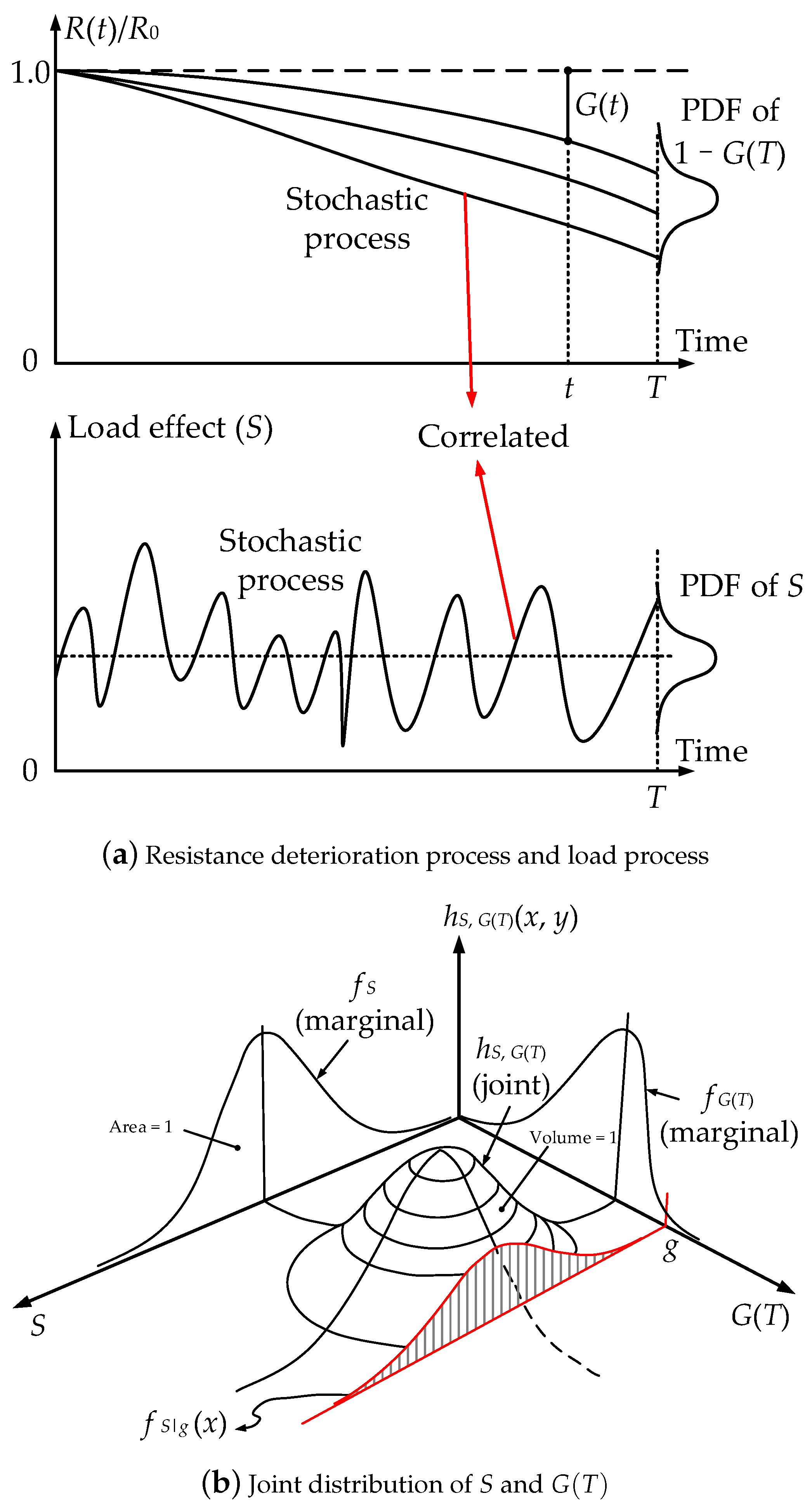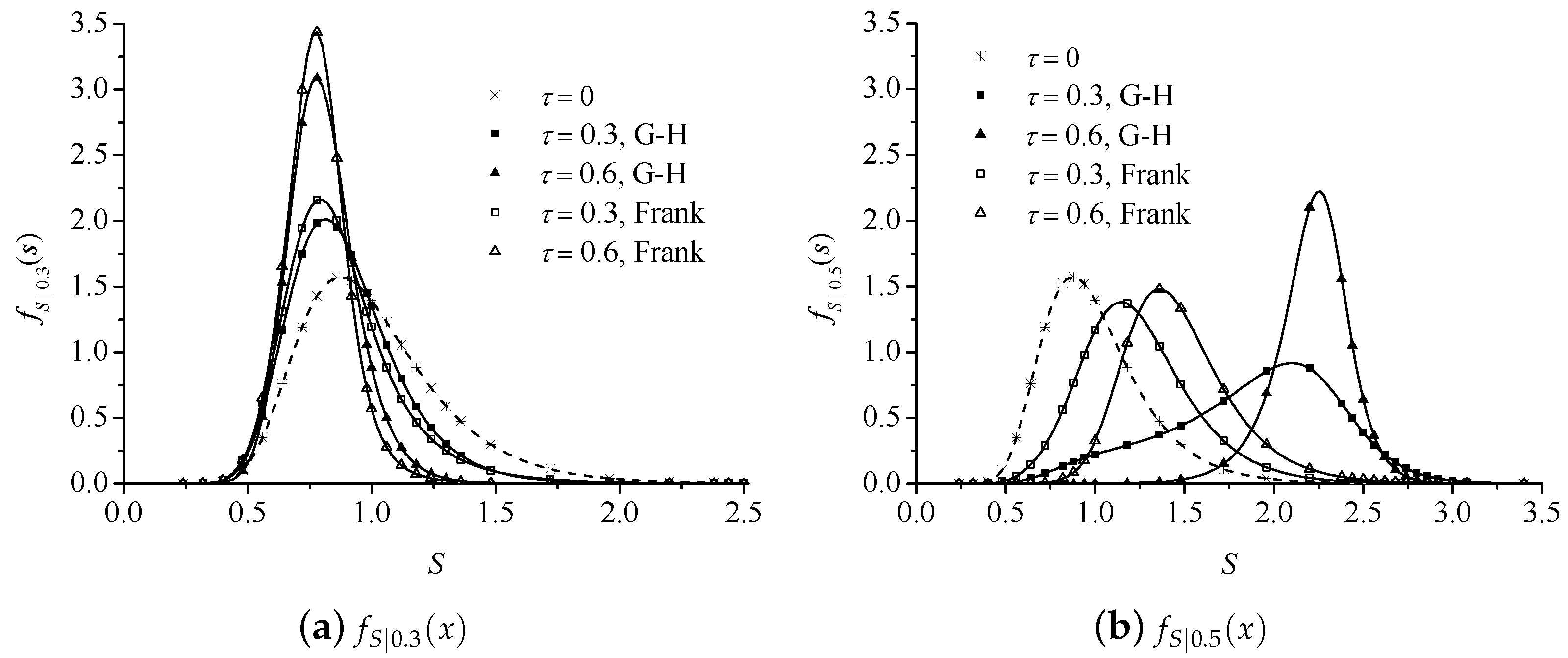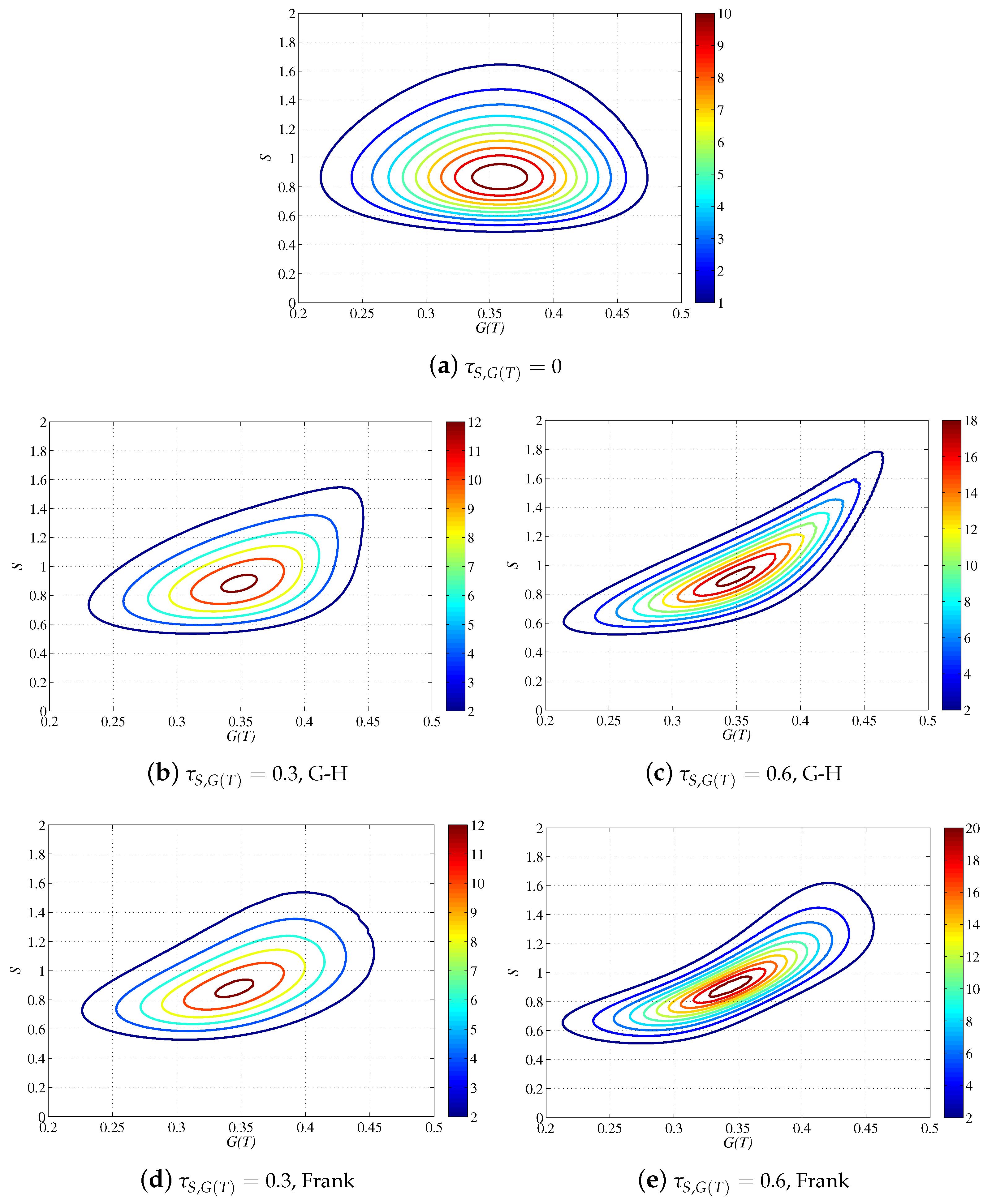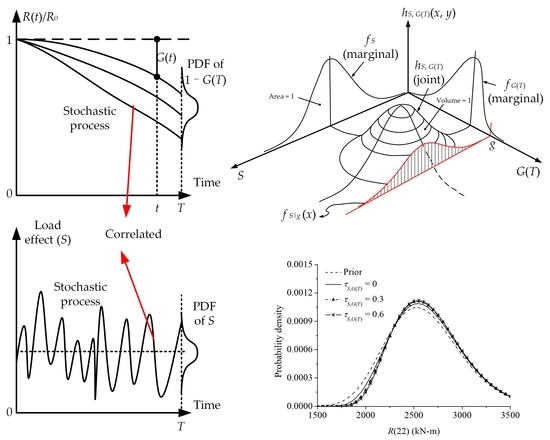1. Introduction
In-service bridges may suffer from aggressive environments and increasing traffic loads and volumes, which may cause the degradation in their load capacity and serviceability. Evaluations often should be made regarding the safety of these bridges, providing quantitative evidence that they can withstand future load events with an acceptable level of reliability during future service lives. Significant uncertainties are unavoidably associated with the estimate of load-carrying capacity of an existing bridge, because many factors affect the degradation process, including environmental conditions, traffic loads and volumes and quality of periodic maintenance, whose exact influences on structural degradation are difficult to predict. To increase the accuracy in the estimate of resistance and reliability of existing bridges, an effective way is to update the probabilistic resistance models using in-site information that are representative of the site characteristics, e.g., service load history. Historical survived loads are evident of the performance of existing structures as they can be regarded as incomplete load tests. The estimate of resistance and reliability of an existing bridge can be updated using these data as long as the load history was measured and accounted for reasonably [
1,
2,
3,
4].
The work by Hall [
1] was one of the first attempts to reassess the resistance of existing structures using the data of survived service loads. In later researches, the method was further used to update the reliability of existing bridges [
5] and to update the piping reliability of flood defenses [
6] based on survived load information. However, Hall [
1] treated the structural resistance as a random variable, which is independent of the age of the structure; as a result, the effect of resistance deterioration cannot be accounted for in that method. The resistance deterioration has a significant impact on the reliability of existing structures within future service lives, as demonstrated by Stewart and Val [
7], who investigated the negative effects of structural deterioration and positive effects of service load history on the updated resistance of aging structures through complex Monte Carlo simulation analysis, showing the necessity to model the structural deterioration process stochastically. Li and Wang [
3] proposed close-form formulas to update the estimates of structural current resistance, initial resistance and reliability for subsequent years in the context of time-dependent reliability. However, in to-date updating methods, the resistance deterioration process was assumed independent of the load history process; such assumption is unrealistic in many cases, for example, significant load events may cause shock deterioration to the resistance of engineering structures and contribute to the accumulation of structural fragility, indicating the association between the resistance deterioration and load processes [
8,
9,
10]. The question arises then regarding the effect of deterioration-load dependency in updating the resistance of existing aging bridges using prior service loads.
This paper investigates the role of correlation between resistance deterioration and load processes in updating the resistance of existing aging bridges with successful load history information. A closed form formula is proposed to update the estimate of current resistance taking into account the uncertainty associated with the time-variant resistance and the deterioration-load dependency. Through reassessing the resistance of an existing reinforced concrete beam bridge, the application of the proposed method is illustrated, and the effect of deterioration-load dependency on the updated resistance is investigated parametrically.
2. Resistance Deterioration Process
For an aging bridge, the structural resistance deteriorates in time due to damage accumulation caused by load effects and environmental attacks. The time-variant resistance changes in time according to Equation (
1), where
is the resistance at time
t;
is the initial resistance and
is the deterioration function (a stochastic process). In this paper,
is assumed independent of
.
Without rehabilitation or other types of strengthening, the deterioration process
is by nature a non-increasing complex stochastic process [
11,
12,
13]. However, some relatively rudimentary/simplified models of resistance deterioration (e.g., fully correlated stochastic process), as in previous studies regarding reliability analysis of aging infrastructure [
14,
15,
16,
17], may also account for the main characteristics of structural deterioration. Moreover, Li et al. [
18] reported that when performing structural time-dependent reliability analysis, the resistance deterioration process may be approximated reasonably as a fully correlated one. As a result, in this paper, the resistance deterioration process is modeled as fully correlated, as described in Equation (
2),
where
a is a random variable which accounts for the randomness of
and
is a parameter representing the deterioration type. For example,
and 0.5 corresponds to deterioration due to corrosion of reinforcement, sulfate attack and diffusion-controlled aging, respectively [
19].
3. Deterioration-Load Dependency
A stochastic load process and a fully correlated deterioration process of a bridge are shown in
Figure 1a. For purpose of simplicity, the load process is assumed to be stationary. The service life of
T years of the structure is divided into
n identical discrete time intervals
,
,
, and the CDF (cumulative density function) and PDF (probability density function) of the maximum load effect,
S, experienced during each time interval are
and
respectively. Suppose that the current resistance of the bridge,
, is evaluated and its PDF is
. According to the probability distribution of initial resistance and keeping in mind the deterioration process is fully correlated, the PDF of
can be obtained, denoted by
. Taking into account the correlation between the load process and the deterioration process, a schematic diagram for the joint probability distribution of correlated
and
S,
, is shown in
Figure 1b (after [
20]). Corresponding to different deterioration value,
g, the conditional PDF of
S,
, changes as a result of deterioration-load dependency. Physically
and
S can be treated as positively correlated.
With the marginal distributions of
S and
given and denoted as
and
respectively, according to Sklar’s Theorem [
21], there exists such a copula function that can be employed to construct the joint function of
S and
. With this, the joint distribution function of
S and
,
, takes the form of
where
is the copula function. With Equation (
3), the conditional CDF of
S on
,
, is obtained as follows,
Mathematically, various measures can be used to describe the correlation between two random variables, such as linear correlation (Pearson correlation) and rank correlation (e.g., Kendall’s tau) [
22]. The Pearson correlation is commonly used to measure the bivariate linear association, and is very sensitive to the non-normality of the variables (e.g., [
23]). Note that the load intensity and damage accumulation is usually non-normal and physically nonlinear. Thus, the rank-type Kendall’s tau is employed in this paper to describe the correlation between the load process and the deterioration process. For random variables
X and
Y, the Kendall correlation coefficient,
, is defined as the probability of concordance minus the probability of discordance for a pair of observations
and
chosen from the samples of
randomly, i.e.,
where Pr( ) denotes the probability of the event in the bracket. Note that for two random variables, various copula functions may exist leading to identical bivariate Kendall’s tau. In the paper, two types of copula functions, namely Gumbel-Hougaard copula [
24] and Frank copula [
25] will be utilized to construct the joint function of
S and
. For the Gumbel-Hougaard (G-H for abbreviation) copula,
and for the Frank copula,
It is noticed that only one parameter,
, is involved in both Equations (
6) and (
7), which is by nature related to the Kendall’s tau,
. The relationship between
and
for the two copula functions can be found in
Appendix A. Substituting Equations (
6) and (
7) into Equation (
3) and conditioning
as
g,
can be obtained according to Equation (
4). For illustration purpose,
Figure 2 plots
and
for the cases of
and 0.6 respectively employing the two copula functions, where
S follows an Extreme type I distribution with a mean value of 1 and a standard deviation of 0.3, while
follows a lognormal distribution with a mean value of 0.35 and a standard deviation of 0.06. It is seen that with
S and
modeled positively correlated, if
g is less than the mean value of
, the conditional distribution of
S shifts leftwards slightly and becomes narrower compared with the prior distribution, indicating that the variance of conditional
S is significantly reduced; when
g is greater than the mean value of
, the conditional distribution of
S moves rightwards obviously, implying that the mean value of conditional
S is increased by the positive correlation between
S and
. In addition, the choice of copula function also affects the probabilistic behavior of conditional
S provided the same correlation coefficient, and the difference between the prior and conditional distributions of
S is more significant for the case of Frank copula.
Furthermore, in order to visualize the dependence structure of
S and
,
Figure 3 presents the contour plots of the joint PDF of
S and
,
, associated with G-H and Frank copula functions for the cases of
, 0.3 and 0.6. It is seen that the difference between the dependence structures of
S and
for different correlation coefficients or copula functions is significant, although the marginal distributions of
S and
are fixed for the five cases as in
Figure 2. The effect of this difference on updating the structural resistance will be discussed later.
5. Case Study
The Qingfang Bridge is located in the southeast of Tianjin province, China, about 1.5 km away from Bohai Bay. The bridge has a service life of 22 years, and the deterioration of the bridge’s resistance is mainly triggered by the chloride-induced corrosion of reinforcing bars [
3]. It is chosen to illustrate the applicability of the proposed methods in this paper. The detailed configuration (including photo, deck section and girder section) of this bridge can be found in [
3] and are listed in
Table 1. The bridge is subjected to the combination of dead load and live (traffic) load. The estimate of the bridge’s current resistance
will be considered, taking into account its successful service history. For the purpose of comparison, two live load intensities are considered, i.e., Case 1,
kN·m; Case 2,
kN·m, where
denotes the mean value of the live load. The coefficient of variation (COV) of the live load is 0.18 for both cases.
In order to demonstrate the impact that the correlation coefficient of
S and
has on updating the estimate of current resistance,
Figure 4 plots the updated estimates of
obtained from Equation (
11), where the Kendall’s tau,
, is set as 0, 0.3 and 0.6 respectively. The service life,
years, is divided into 22 identical sections by year, and the resistance is assumed to degrade linearly (i.e.,
in Equation (
2)) for all cases, due to the dominating deterioration mechanism of chloride-induced corrosion of reinforcing bars. The service loads cause the failure of some deficient bridges, so the lower tail of the resistance distribution is truncated. The correlation between
S and
affects the updated distribution of
. For instance, for the case of
kN·m with G-H copula employed, the mean values of updated
are 2712.9 kN·m, 2716.7 kN·m and 2704.8 kN·m respectively corresponding to
, 0.3 and 0.6, while the standard deviations of
are 352.3 kN·m, 345.2 kN·m and 347.7 kN·m accordingly. For the case of
kN·m with Frank copula, the mean values of updated
are 2646.1 kN·m, 2659.3 kN·m and 2663.9 kN·m when
, 0.3 and 0.6 respectively, while the corresponding standard deviations of
are 376.8 kN·m, 369.0 kN·m and 366.2 kN·m. In terms of the lower tail behaviour of
, ignoring the deterioration-load dependency will shift the distribution leftwards and thus yields a conservative estimate of the updated resistance. The difference between the probabilistic behavior of updated
associated with different
can be explained by the fact that
contributes to the variation of
(see
Table 2), while the truncation of the distribution of updated resistance is related to the failure of the bridges (c.f. the denominator of Equation (
8)). This explanation will also hold for other values of
T (i.e., duration of service period) according to Equation (
8). From the observations in
Figure 4, it is suggested that one may update the estimate of bridge resistance with the assumption of independent deterioration and load processes in an attempt to achieve a relatively conservative assessment in the presence of incomplete information on the deterioration-load dependency. Finally, it is noticed that the greater the failure probability within the past service period, the more significant the difference between the prior and updated current resistances.











